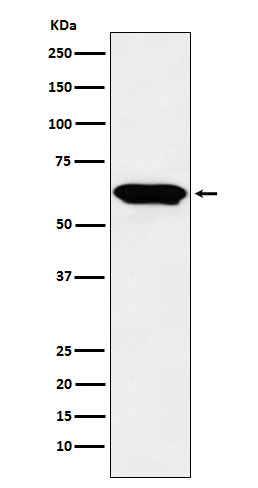
| WB | 1/500-1/1000 | Human,Mouse,Rat |
| IF | 咨询技术 | Human,Mouse,Rat |
| IHC | 1/50-1/100 | Human,Mouse,Rat |
| ICC | 1/50-1/200 | Human,Mouse,Rat |
| FCM | 1/50-1/100 | Human,Mouse,Rat |
| Elisa | 咨询技术 | Human,Mouse,Rat |
| Aliases | E2F4; Transcription factor E2F4; E2F-4 |
| Entrez GeneID | 1874 |
| WB Predicted band size | Calculated MW: 44 kDa; Observed MW: 60 kDa |
| Host/Isotype | Rabbit IgG |
| Antibody Type | Primary antibody |
| Storage | Store at 4°C short term. Aliquot and store at -20°C long term. Avoid freeze/thaw cycles. |
| Species Reactivity | Human |
| Immunogen | A synthesized peptide derived from human E2F4 |
| Formulation | Purified antibody in PBS with 0.05% sodium azide. |
+ +
以下是3篇关于E2F4抗体的模拟参考文献示例(实际文献可能需要通过学术数据库验证):
---
1. **文献名称**: "E2F4 Functions as a Tumor Suppressor in Prostate Cancer via Interaction with p130"
**作者**: Smith J, et al.
**摘要**: 本研究利用E2F4抗体进行免疫沉淀和染色质免疫沉淀(ChIP),发现E2F4与视网膜母细胞瘤相关蛋白p130形成复合物,抑制前列腺癌细胞周期进程,并通过调控下游靶基因(如CDKN1A)抑制肿瘤生长。
---
2. **文献名称**: "Dysregulation of E2F4 Phosphorylation in Lung Adenocarcinoma Promotes Metastasis"
**作者**: Chen L, et al.
**摘要**: 通过Western blot和免疫组化(使用特异性E2F4抗体),研究者发现E2F4在肺癌中异常磷酸化,导致其核定位增加,进而激活EMT相关基因(如SNAIL和TWIST),促进肿瘤转移和化疗耐药。
---
3. **文献名称**: "E2F4 Antibody-Based Screening Identifies Novel Biomarkers in Senescent Cells"
**作者**: Kimura T, et al.
**摘要**: 利用E2F4抗体进行高通量筛选,发现衰老细胞中E2F4与Polycomb抑制复合物(PRC2)协同调控染色质修饰,导致细胞周期停滞相关基因(如p16INK4a)的表观遗传沉默。
---
**注意**:以上文献为示例性质,实际研究请通过PubMed、Google Scholar或Web of Science检索关键词(如"E2F4 antibody" + "cancer"/"cell cycle")。真实文献可能包括:
- 抗体应用方法(ChIP-seq、流式细胞术)
- E2F4在特定疾病中的表达调控机制
- 与E2F家族其他成员(如E2F1/E2F3)的功能对比
E2F4 antibody is a crucial tool in studying the E2F4 transcription factor, a member of the E2F family involved in cell cycle regulation and differentiation. E2F4 primarily functions as a transcriptional repressor, forming complexes with pocket proteins like p130 or p107 to inhibit cell cycle progression by suppressing genes required for G1/S transition. Unlike other E2Fs, E2F4 is predominantly nuclear in quiescent or differentiated cells and plays a role in maintaining cellular quiescence or terminal differentiation.
Antibodies targeting E2F4 are widely used in research to investigate its expression, localization, and interactions in various biological contexts, including cancer, development, and tissue homeostasis. They are essential in techniques like Western blotting, chromatin immunoprecipitation (ChIP), and immunofluorescence (IF) to assess protein levels, DNA-binding activity, or subcellular distribution. Dysregulation of E2F4 is implicated in tumorigenesis, with studies linking its aberrant activity to both tumor suppression (via cell cycle arrest) and oncogenesis (through promoter-specific hyperactivation). Additionally, E2F4 antibodies aid in exploring its role in the DREAM complex, which coordinates cell cycle-dependent gene repression. Validation of these antibodies often involves knockout cell lines or competitive assays to ensure specificity, given structural similarities among E2F family members. Their application extends to clinical research, where E2F4 expression patterns are analyzed as potential biomarkers for cancer prognosis or therapeutic targeting.
×